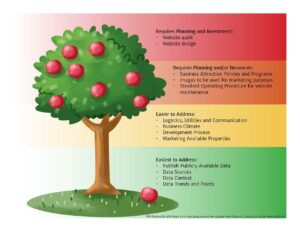Communities are organic beings. They grow or shrink; they can thrive or become ghosts. They can become physically diseased with blight and outdated infrastructure or face social plagues such as drug dependence, violence or systemic poverty. But like all other beings, they can also find healing by addressing their health problems head-on; strength by challenging their current capacity; and resilience by overcoming mounting adversity.
None of these things – healing, strength or resilience – can come unless the community is first both aware of its challenges and willing to completely let go of what it currently is / has been in order to address them. Beyond this, there must be an understanding that through this process of healing, growth, and change, the community will become something different from what it ever was before. Undoubtedly, systemic change aimed at healing disease, building capacity, and cultivating resiliency will encounter roadblocks. But it is through these challenges that the true test is met:
“The single factor that will do the most to change a culture toward acceptance of development … is the process of overcoming the challenges that face [the] community in difficult times. If communities come together to face change, they will adapt and thrive. If they don’t come together, they will pass away just like any other organic entity.”
— John Woods
Invest in Transformation
The process of overcoming challenges – that is, coming to an obstacle and surmounting it – is the driving factor in transformational change for both people and communities. It is in this process that resilience is formed, and through this process that new, or emergent community identities are forged. By shedding the past and investing in the future, communities can position themselves as home for unmet generations, and improve their odds for survival during challenges yet unseen.
Incentivize Change
Encouraging the types of investment required for sustained, systemic change may require the investment of public funds in the form of incentives. Incentives are a critical factor for projects that would not gain traction in the private market, yet serve the broader public good. By leveraging public dollars for the purpose of engaging in transformational investments, a community can take a proactive role in shaping their future.
Incentives are a topic of debate among economic development professionals as well as the public at large. Beyond the stated standard practice, I would contend that so long as the incentive is an investment – a strategic choice that results in growth (i.e. increased monetary base, enhanced workforce skills, etc.) throughout the broader system, they are a wise choice. Cultivating change is a difficult task, and is nearly impossible if a community asks the private sector to bear the entire burden.
Initiatives for Youth
Systemic change initiatives face a myriad of challenges – vested interests, conflicting opinions and comfort zones tend to muddy the water for the folks burdened with developing policy and/or implementing plans. Often, community leaders are well-seasoned, experienced people with a well-developed (and somewhat static) vision for what the community is – or can become. While dialogue may include topics such as empowering or engaging youth in the process, it is generally done via the bureaucracies of the school system, rather than engaging the under-25 year-old population directly.
This, of course, encourages the disengagement of a critical population in communities that are seeking healing from current physical and/or social disease or future growth. Community leaders must engage their prime customers – under-25 year-olds – in planning and implementation if they are to have any hope of retaining them as a quality future workforce and future leaders. Direct engagement is not without challenges; but without this critical piece, the broader challenges will only mount.
Interestingly, youths are generally endowed with an incredible capacity to adapt and change as obstacles or challenges impede their goals. This particular trait makes the youth in a community an invaluable asset when mental fatigue gets the edge on tenacity when implementing change. The ability to bounce back – to identify solutions and alternatives at each roadblock – is critical to building community resilience and strength when engaging in community healing.
Though it has become cliché to pound the ‘invest in our youth’ drum, is it not also interesting that sustained efforts to do so are fewer in number and often piecemeal or limited in scope? This paradox feeds generational stereotypes, limits a community’s boomerang capacity, and ultimately erodes the quality of the workforce for the long-term.






